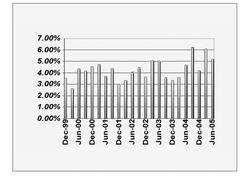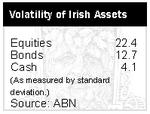|
|
Sunday, 7th December 2025 |
| The cash decision is a richly layered one for investors, both money managers and corporate treasurers alike. Where interest rates are headed not only determines where you want to be along the curve, but is also perhaps the key driver of where you want to be as regards the wider range of other asset classes, equities, bonds, property, alternatives etc. for those who have that flexibility of mandate. In this sense, cash is something of a ‘gateway’ asset, writes Eugene Kiernan. |
Cash is a less volatile asset class and the numbers back it up. Looking at Irish numbers for the period 1900- 2004 and standard deviation of returns as one measure of risk, cash naturally is significantly less volatile than government bonds, which in turn are significantly less volatile than stocks. | | Eugene Kiernan |
What role does cash play in investor portfolios? For long-term investors, cash is not a strategic asset, but can be a very important tactical one. For long-term portfolios such as pension funds, the natural home is in real assets such as equities or property. This is borne out by looking at the same long term data as above on Irish asset returns. In real terms, the average annual return from stocks over the past 100 years was 4.7 per cent compared to a smaller 0.7 per cent for cash and 1.1 per cent for fixed income.
The long-term investor will seize on this relationship and stick with stocks or property for the vast bulk of the portfolio. As Figure 1 shows, Irish pension funds typically hold a relatively stable allocation to cash. Looking back over the last five years, cash levels have never gone below 2.6 per cent and equally rarely have pushed over 6 per cent. The average holding in cash over this period, was just over 4 per cent. Market movements of the other asset classes have played a bigger role in determining this cash allocation than an actual targeting by fund managers.
Funds with a shorter-term perspective or with an absolute return objective may well be a more willing holder of cash. At a time of severe volatility in markets cash will be a welcome safe harbour. Market timing becomes a critical skill to have when opting for this cash option. Several high profile ‘value’ investors who made who made a ‘dash for cash’ in the latter part of the 1990s may have been proven right by the subsequent bursting of the stock market bubble in 2000-2001 but saw assets under management haemorrhage in the interim period. Funds and careers suffered. | | Figure 1: Cash levels in Irish pension funds |
Clearly, cash has differing relevance for investors depending on which of the above camps they fall into. But both have a decision to make and the question is how does cash stack up today in this investment spectrum?
The simple fact is that global interest rates are higher today than 18 months ago. This, if nothing else, increases the attraction of cash as an asset. It is interesting to note that in the US, the most recent data available does show a re awakening of interest in cash funds after a fairly consistent pattern of exits.
When interest rates were at their lows such as 1 per cent in the US or 3.5 per cent in the UK, dividend income from quality stocks in both markets was higher than cash income. Investors were being extremely well rewarded for taking the risk of owning what were in most cases well capitalised, highly cash generative companies. This was a very bullish signal for markets. Today that’s no longer the case. Our own central view would be that there is more to go for in stocks but that extreme valuation case compared to cash rates is no longer intact.
As regards the future direction of global interest rates we expect them to display the same level of collective co-ordination as a herd of cats.
US interest rates are likely to continue on their gradual climb. Where does the Fed want to stop? What is a neutral level for US rates? Neutral has in the past only been a ‘passing phase’ for US rate policy as rates have passed through the long term average and usually kept on going. We feel that the Fed will continue to move rates up until some signs of a cooling in the US housing market emerge. | | Volatility of Irish Assets |
The UK may well be in a ‘wait and see’ mode. It didn’t take a lot of data from the High Street and housing market for the Bank of England to move to the side lines and actually reverse policy. Most of the heavy lifting has been done as regards UK interest rates. We may be here for some time.
Eurozone interest rates are set to rise – but at some stage and not necessarily soon. The ECB will likely drive up the rhetoric on a move to higher rates but with signs of renewed economic growth still only emerging and core inflation that is between 1 and 2 per cent, there should be no urgency around the decision. As the ECB matures it may well become more ‘Fed’ like and look to trends in underlying Eurozone economy and may seek to influence issues such as credit growth etc. Near term the odds are against a change in rates.
Over the next 12 months, we expect global interest rates to be higher than where we are today- but not by very much. The bulk of the upward move in interest rates is behind us. For corporate treasurers this will be a key determinant of how far out they place cash.
For longer-term investors, given the outlook for economic and profit growth and given that market volatility (as measured for example by standard industry measures such as VIX indices) still reasonably low, we believe that real assets such as property or equities will remain the assets of choice. |
Eugene Kiernan is head of asset allocation at Irish Life Investment Managers.
|
| Article appeared in the September 2005 issue.
|
|
|